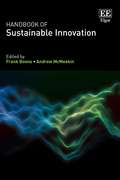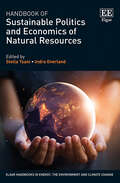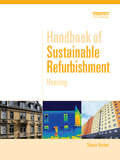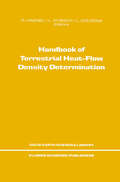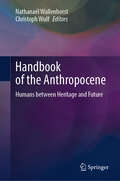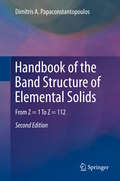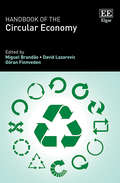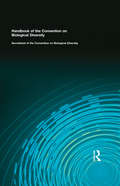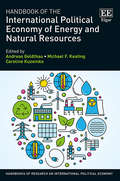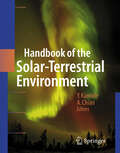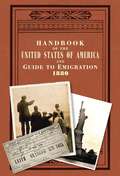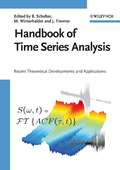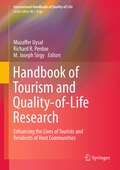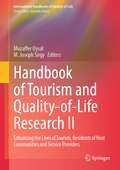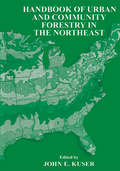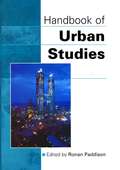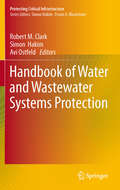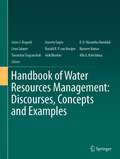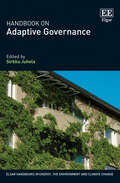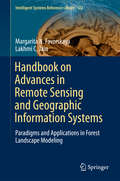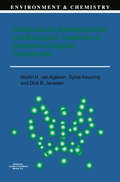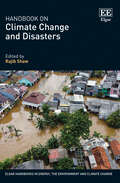- Table View
- List View
Handbook of Sustainable Innovation
by Andrew McMeekin Frank BoonsThe Handbook of Sustainable Innovation maps the multiple lineages of research and understanding that constitute academic work on how technological change relates to sustainable practices of production and consumption. Leading academics contribute by mapping the general evolution of this academic field, our understanding of sustainable innovation at the firm, user, and systems level, the governance of sustainable innovation, and the methodological approaches used. The Handbook explores the distinctiveness of sustainable innovation and concludes with suggestions for generating future research avenues that exploit the current diversity of work while seeking increased systemic insight. This unique and original book will have a broad appeal among scholars, researchers and advanced students interested in innovation, environmental studies and technological transitions.
Handbook of Sustainable Politics and Economics of Natural Resources (Elgar Handbooks in Energy, the Environment and Climate Change)
This timely Handbook draws together insightful analyses of natural resource management challenges and solutions in the face of sustainable development targets and a changing global climate. Expert contributors illustrate the ways in which resource- and region-specific challenges shape national and global strategies, exploring the institutional aspects of resource management and their implications for policy making. They consider the economic, legal, environmental, social, financial and technological dimensions of resource management, consolidating interdisciplinary knowledge and setting the agenda for future research. Advancing scientific knowledge in the field, the Handbook offers a roadmap for well-informed policy making, highlighting the uncertainties and risks associated with climate change, energy and sustainability transition, and the need for a forward-looking approach to resource management. Assembling state-of-the-art contributions to provide a clearer understanding of the transformative policy developments ahead, this Handbook is crucial reading for academics and researchers of resource management, public policy, sustainability, energy transition, climate change and environmental studies. It also offers critical empirical insights for policy makers and practitioners developing innovative strategies to meet sustainability targets.
Handbook of Sustainable Refurbishment: Housing
by Simon BurtonBased on careful analysis and experience in all housing sectors and house types, this handbook explains and demonstrates how to incorporate the most effective energy saving measures in the existing housing stock.It begins by setting out the basic aims of sustainable refurbishment before presenting a large number of illustrated case studies from a range of single- and multi-family dwellings. A practical section then details the specific measures that can be taken to reduce the energy demand of buildings, with extensive references to further resources. Written for architects and building engineers, the book combines technical and managerial solutions demonstrating that a new refurbishment culture needs to be created that radically improves the energy performance of all existing houses whenever any opportunity presents itself and whenever any work is carried out.
Handbook of Sustainable Refurbishment: Housing
by Simon BurtonBased on careful analysis and experience in all housing sectors and house types, this handbook explains and demonstrates how to incorporate the most effective energy saving measures in the existing housing stock.It begins by setting out the basic aims of sustainable refurbishment before presenting a large number of illustrated case studies from a range of single- and multi-family dwellings. A practical section then details the specific measures that can be taken to reduce the energy demand of buildings, with extensive references to further resources. Written for architects and building engineers, the book combines technical and managerial solutions demonstrating that a new refurbishment culture needs to be created that radically improves the energy performance of all existing houses whenever any opportunity presents itself and whenever any work is carried out.
Handbook of Terrestrial Heat-Flow Density Determination: with Guidelines and Recommendations of the International Heat Flow Commission (Solid Earth Sciences Library #4)
by R. Haenel L. Stegena Ladislaus RybachThere comes a time in the affairs of every organization when we have to sit down and take stock of where we are and where we want to go. When the International Heat Flow Committee (as it was first called), IHFC, was formed in 1963 at the San Francisco International Union of Geodesy and Geophysics with Francis Birch as its first Chairman, the principal purpose was to stimulate work in the basic aspects of geothermics, particularly the measurement of terrestrial heat-flow density (HFD) in what were then the 'geothermally underdeveloped' areas of the world. In this, the IHFC was remarkably successful. By the beginning of the second decade of our existence, interest in the economic aspects of geothermics was increasing at a rapid pace and the IHFC served as a conduit for all aspects of geothermics and, moreover, became the group responsi ble for collecting data on all types of HFD measurements. In all the tasks that are undertaken, the IHFC relies on the enthusiasm of its members and colleagues who devote much of their time to the important but unglamorous and personally unrewarding tasks that were asked of them, and we arc fortunate that our parent institutions are usually quite tolerant of the time spent by their employees on IHFC work.
Handbook of the Anthropocene: Humans between Heritage and Future
by Nathanaël Wallenhorst Christoph WulfThis Handbook is a collection of contributions of more than 300 researchers who have worked to grasp the Anthropocene, this new geological epoch characterised by a modification of the conditions of habitability of the Earth for all living things, in its biogeophysical and socio-political reality. These researchers also sought to define a historical and prospective anthropology that integrates social, economic, cultural and political issues as well as, of course, environmental ones. What are the anthropological changes needed to ensure that our human adventure will be able to continue in the Anthropocene? And what are the educational and political issues involved?Anthropocene is fast becoming a widely-used term, but thus far, there been no reference work explaining the thoughts of the greatest experts of the present day on this subject (at the intersection of biogeophysical and socio-political knowledge). A scientific and political concept (but which is also theconceptual vehicle for conveying the scientific community's sense of concern), this complex term is explained by international experts as they reflect on scientific arguments taking place in earth system science, the social sciences and the humanities. What these researchers from different disciplines have in common is a healthy concern for the future and how to prepare for it in the Anthropocene and also the identification of possible anthropological changes. This Handbook encourages readers to immerse themselves in reflections on the human adventure through descriptions of our differing heritages and the future that is in the process of being written.
Handbook of the Band Structure of Elemental Solids: From Z = 1 To Z = 112
by Dimitris A. PapaconstantopoulosThis handbook presents electronic structure data and tabulations of Slater-Koster parameters for the whole periodic table. This second edition presents data sets for all elements up to Z = 112, Copernicium, whereas the first edition contained only 53 elements.In this new edition, results are given for the equation of state of the elements together with the parameters of a Birch fit, so that the reader can regenerate the results and derive additional information, such as Pressure-Volume relations and variation of Bulk Modulus with Pressure. For each element, in addition to the equation of state, the energy bands, densities of states and a set of tight-binding parameters is provided.For a majority of elements, the tight-binding parameters are presented for both a two- and three-center approximation. For the hcp structure, new three-center tight-binding results are given. Other new material in this edition include: energy bands and densities of states of all rare-earth metals, a discussion of the McMillan-Gaspari-Gyorffy theories and a tabulation of the electron-ion interaction matrix elements. The evaluation of the Stoner criterion for ferromagnetism is examined and results are tabulated. This edition also contains two new appendices discussing the effects of spin-orbit interaction and a modified version of Harrison's tight-binding theory for metals which puts the theory on a quantitative basis.
Handbook of the Circular Economy
This crucial Handbook investigates an urgent area for policy-makers, academia and industries alike: the circular economy. International experts on the subject bring together the latest thinking on this critical global issue. Providing a comprehensive overview of the mechanisms and consequences of the circular economy, as well as its limitations, it raises important questions concerning how the world should proceed when non-renewable resources, such as fossil fuels and minerals, are being depleted and the environment is struggling to cope with the waste and emissions of unsustainable production and consumption systems. Contributors explore a broad range of themes, such as new sustainable production and consumption systems, new design requirements, recycling systems, new business models and the social impacts of the circular economy, while also consolidating the many ways in which the topic has been dealt with in research, business and policy-making. Shedding light on a concept that has become increasingly relevant during the last decade, the Handbook of the Circular Economy is essential reading for students, academics and policy-makers trying to make sense of the plethora of ways in which the term has been applied and interpreted.
Handbook of the Convention on Biological Diversity
by Secretariat To CbdIn 1992, at the Earth Summit in Rio, the United Nations adopted the Convention on Biological Diversity (CBD) to agree international measures aimed at preserving the vital ecosystems and biological resources on which we all depend. This is the official handbook to the Convention and presents all the most important information about the CBD, including a guide to the decisions adopted and to ongoing activities. It is an essential resource for all the governments, intergovernmental agencies, NGOs and conservation bodies and researchers working in this area. Included with the book is a fully indexed and cross-referenced CD-ROM containing all the relevant background material to the Convention, linked to relevant decisions and other sources of information.
Handbook of the Convention on Biological Diversity
by Secretariat To CbdIn 1992, at the Earth Summit in Rio, the United Nations adopted the Convention on Biological Diversity (CBD) to agree international measures aimed at preserving the vital ecosystems and biological resources on which we all depend. This is the official handbook to the Convention and presents all the most important information about the CBD, including a guide to the decisions adopted and to ongoing activities. It is an essential resource for all the governments, intergovernmental agencies, NGOs and conservation bodies and researchers working in this area. Included with the book is a fully indexed and cross-referenced CD-ROM containing all the relevant background material to the Convention, linked to relevant decisions and other sources of information.
Handbook of the International Political Economy of Energy and Natural Resources (Handbooks of Research on International Political Economy series)
by Caroline Kuzemko Andreas Goldthau Michael F. KeatingThis Handbook offers a comprehensive overview of the latest research from leading scholars on the international political economy of energy and resources. Highlighting the important conceptual and empirical themes, the chapters study all levels of governance, from global to local, and explore the wide range of issues emerging in a changing political and economic environment. The original contributions analyse energy as a highly complex, interconnected policy area, including how energy markets and regimes are constituted and the governance institutions that are being designed to challenge existing establishments. A number of contributors focus on intersections between energy and other policy fields or sectors, or nexes. These include the climate change, energy and low carbon transitions nexus; the food, water and forestry nexus; the energy, resources and development nexus; and the global–national–local nexus in energy. Significantly, this Handbook ties the contributions together by exploring opportunities for sustainable transitions and avoiding resource scarcity whilst taking other social needs, such as development, into account. This Handbook will be an essential resource for scholars and students of international political economy, governance and development studies as it covers: the environment, development, human rights, global production, energy transitions and energy security.
Handbook of the Solar-Terrestrial Environment
by Yohsuke Kamide Abraham C. L ChianAs a star in the universe, the Sun is constantly releas- cover a wide range of time and spatial scales, making ?? ing energy into space, as much as ?. ? ?? erg/s. Tis observations in the solar-terrestrial environment c- energy emission basically consists of three modes. Te plicated and the understanding of processes di?cult. ?rst mode of solar energy is the so-called blackbody ra- In the early days, the phenomena in each plasma diation, commonly known as sunlight, and the second region were studied separately, but with the progress mode of solar electromagnetic emission, such as X rays of research, we realized the importance of treating and UV radiation, is mostly absorbed above the Earth’s the whole chain of processes as an entity because of stratosphere. Te third mode of solar energy emission is strong interactions between various regions within in the form of particles having a wide range of energies the solar-terrestrial system. On the basis of extensive from less than ? keV to more than ? GeV. It is convenient satellite observations and computer simulations over to group these particles into lower-energy particles and thepasttwo decades, it hasbecomepossibleto analyze higher-energy particles, which are referred to as the so- speci?cally the close coupling of di?erent regions in the lar wind and solar cosmic rays, respectively. solar-terrestrial environment.
Handbook of the United States of America, 1880: A Guide to Emigration
by Lp BrockettMillions of immigrants entered America's "golden door†? in the years after 1880. This authentically reproduced Handbook of the United States was a trusted resource that told them everything they needed to know as they strove to become Americans. America's "golden door†? welcomed a huge wave of European immigrants between the 1880s and the 1920s. Millions passed through the gateway of the Statue of Liberty and Ellis Island on their way to becoming Americans, and The Handbook of the United States is an authentic reproduction of one of the immigrants' most trusted resources- a complete guide to the USA, including everything from the pay-rates of various trades to amusing statistics about what Americans ate, drank, and manufactured. Once the tool that helped thousands of Irish, Italian and Jewish immigrants use their drive and industriousness to succeed, today it provides new insights into the extraordinary circumstances of the immigrant experience and the new arrivals' remarkable contribution to making America a great global power.
Handbook of Time Series Analysis: Recent Theoretical Developments and Applications
by Bjö Schelter Matthias Winterhalder Jens TimmerThis handbook provides an up-to-date survey of current research topics and applications of time series analysis methods written by leading experts in their fields. It covers recent developments in univariate as well as bivariate and multivariate time series analysis techniques ranging from physics' to life sciences' applications. Each chapter comprises both methodological aspects and applications to real world complex systems, such as the human brain or Earth's climate. Covering an exceptionally broad spectrum of topics, beginners, experts and practitioners who seek to understand the latest developments will profit from this handbook.
Handbook of Tourism and Quality-of-Life Research: Enhancing the Lives of Tourists and Residents of Host Communities (International Handbooks of Quality-of-Life)
by Muzaffer Uysal, Richard Perdue and M. Joseph SirgyQuality of life (QOL) research in tourism has gained much momentum over the last two decades. Academics working in this area research issues related to tourists and host communities. Practitioners are becoming increasingly interested in understanding the science that allows them to develop better marketing and managerial programs designed to enhance the quality of life of tourists. Tourism bureaus and government agencies are increasingly interested in issues of sustainable tourism, specifically in understanding and measuring the impact of tourism on the quality of life of the residents of the host communities. This handbook covers all relevant topics and is divided into two parts: research relating to travelers/tourists, and research relating to the residents of host communities. It is the only state-of-the-art reference book in its field and will prove invaluable to academics interested in QOL research, as well as tourism practitioners interested in applying the science of QOL in the tourism industry.
Handbook of Tourism and Quality-of-Life Research II: Enhancing the Lives of Tourists, Residents of Host Communities and Service Providers (International Handbooks of Quality-of-Life)
by Muzaffer Uysal M. Joseph SirgyThe second volume of this handbook develops on and extends the discussion in the successful first volume, published in 2012. This is a timely addition to the literature, drawing on the momentum that quality of life (QOL) research in tourism has gained in the 21st century and on the boom in the tourism industry itself. It focuses on four areas of growth in QOL research in the recent past: (1) travelers/tourists, (2) host communities, (3) service providers, and (4) the role of technology. The handbook helps management of tourism firms and policy makers develop specific policies and programs to ensure the most positive impact of tourism on tourists, host communities, and service providers. The comprehensive coverage of topics in this handbook makes it a state-of-the-art reference. Academics interested in QOL research in travel and tourism, tourism practitioners interested in applying the science of QOL in the tourism industry, as well as policy makers involved in regulating the industry will view the handbook as indispensable source of recent research.
Handbook of Urban and Community Forestry in the Northeast
by John E. KuserWith the emergence of urban and community forestry as the fastest growing part of our pro fession in the last 15 years, the need for a book such as this inevitably developed. The So ciety of American Foresters' urban forestry working group counts 32 or more universities now offering courses in this subject, and the number is growing. For the last several years I have coordinated a continuing education urban forestry course at Rutgers for nonmatriculated students. Registrants have included arborists, shade tree commissioners, landscape architects, city foresters, environmental commissioners, park superintendents, and others whose jobs involve care and management of trees. The course was started by Bob Tate in 1980, around a core of managerial subjects such as in ventories, budgets, and public relations. After Bob left in 1984 to join Asplundh and later to start his own prosperous business in California, the course languished after it exhausted the local market for those subjects.
Handbook of Urban Studies (PDF)
by Ronan PaddisonThe Handbook of Urban Studies provides the first comprehensive, up-to-date account of the urban condition, relevant to a wide readership from academics to researchers and policymakers. It provides a theoretically and empirically informed account embracing all the different disciplines contributing to urban studies. Leading authors identify key issues and questions and future trends for further research and present their findings so that, where appropriate, they are relevant to the needs of policymakers. Using the city as a unifying structure, the Handbook provides an holistic appreciation of urban structure and change, and of the theories by which we understand the structure, development and changing character of cities.
Handbook of Water and Wastewater Systems Protection (Protecting Critical Infrastructure)
by Robert M. M. Clark, Simon Hakim and Avi OstfeldFollowing the events of 9/11, the Administrator of the US Environmental Protection Agency created the Water Protection Task Force (WPTF), which identified water and wastewater systems as a major area of vulnerability to deliberate attack. The WPTF suggested that there are steps that can be taken to reduce these vulnerabilities and to make it as difficult as possible for potential saboteurs to succeed. The WPTF recommended that be scrutinized with renewed vigor to secure water and wastewater systems against these possible threats. It also recommended that water and wastewater systems have a response plan in place in the event an act of terrorism occurs. The WPTF identified water distribution networks as an area of special vulnerability and highlighted the need for rapid on-line detection methods that are accurate and have a wide detection range. As a result of these recommendations novel technologies from various fields of science and engineering are now addressing water security issues and water and wastewater utilities are looking for innovative solutions. Once such technologies are available, there will be a rapid implementation process that will present many business opportunities for the private sector. However, in addition to terrorist threats water and wastewater systems are inherently vulnerable to natural disasters such as earthquakes and floods. This volume will address the problems associated with both intended terrorist attacks and natural disasters affecting water or wastewater systems. The book is divided into parts based on the kinds of threats facing water and wastewater systems: (1) a direct attack on water and wastewater infrastructure storage reservoirs, and distribution and collection networks; (2) a cyber attack disabling the functionality of the water and wastewater systems or taking over control of key components which might result in system failures; and (3) a deliberate chemical or biological contaminant injection at one of the water distribution system’s nodes. It will examine unique plans, technological and managerial innovations for protecting such systems, and includes descriptions of projects that were implemented to respond to natural disasters. Case studies are presented that discuss existing projects and evaluate their performance, with an emphasis on providing guidelines and techniques that can be implemented by water and wastewater planners and managers to deal with natural and manmade disasters should they occur.
Handbook of Water Resources Management: Discourses, Concepts and Examples
by Janos J. Bogardi Joyeeta Gupta K. D. Wasantha Nandalal Léna Salamé Ronald R. P. van Nooijen Navneet Kumar Tawatchai Tingsanchali Anik Bhaduri Alla G. KolechkinaThis book provides an overview of facts, theories and methods from hydrology, geology, geophysics, law, ethics, economics, ecology, engineering, sociology, diplomacy and many other disciplines with relevance for concepts and practice of water resources management. It provides comprehensive, but also critical reading material for all communities involved in the ongoing water discourses and debates.The book refers to case studies in the form of boxes, sections, or as entire chapters. They illustrate success stories, but also lessons to be remembered, to avoid repeating the same mistakes. Based on consolidated state-of-the-art knowledge, it has been conceived and written to attract a multidisciplinary audience.The aim of this handbook is to facilitate understanding between the participants of the international water discourse and multi-level decision making processes. Knowing more about water, but also about concepts, methods and aspirations of different professional, disciplinary communities and stakeholders professionalizes the debate and enhances the decision making.
Handbook of World Salt Resources (Monographs in Geoscience)
by Stanley J. LefondSixty years ago the Louisiana Geological Survey published "Rock Salt. Its Origin. Geological Occurrences and Economic Importance in the' State of Louisiana, Together with Brief Notes and References to All Known Salt Deposits and Industries of the World" (Bull., 7, 1908, 259 pp.) by G. D. Harris, assisted by G. D. Maury and L. Reineke. The volume which follows is an equally ambitious project, carved out as a labor of love by Stanley J. Lefond, who began the work when he was a geologist with Diamond Alkali Company, Cleve land, Ohio, and finished it when he was a member of the geology staff of United States Borax & Chemical Corp., Los Angeles. Mr. Lefond has done a thorough job, taking full advantage of the discoveries (due in large part to exploration of the subsurface in the search for oil), expanded governmental coverage of mineral deposits, and improved communications, since 1908. The motivation for "The Handbook of World Salt Resources" was the First Symposium on Salt, held in Cleveland in May, 1962, which was sponsored and organized by the relatively young and dynamic Northern Ohio Geological Society. The user of this valuable compilation owes a debt of gratitude to that Society, to the Diamond Alkali Company which donated countless hours of Mr. Lefond's time, and above all, to author Stanley Lefond.
Handbook on Adaptive Governance (Elgar Handbooks in Energy, the Environment and Climate Change)
The interconnectedness of global society is increasingly visible through crises such as the current global health pandemic, emerging climate change impacts and increasing erosion of biodiversity. This timely Handbook navigates the challenges of adaptive governance in these complex contexts, stressing the necessarily compounded nature of biophysical and social systems to ensure more desirable governance outcomes.Highlighting the dynamics and diversity of governance systems across the globe, leading experts in the field examine the successes and failures of these systems. Synthesising theory with methodology and practical case studies, chapters explore adaptive governance in forest management, marine environments and open data ecosystems, looking closely at the role of adaptive governance in climate mitigation and disaster risk reduction. Answering the call for large-scale transformations that move societies away from unsustainable development trajectories, this prescriptive Handbook explores the existing adaptive governance measures that have driven reflexive, sustainable change. Reflecting on the past decade of research in the field, it concludes by outlining new areas of contention and inquiry for the next decade of adaptive governance research.Interdisciplinary in scope, this comprehensive Handbook will prove an invigorating read for students and scholars of environmental law, governance and regulation, and political science and public policy. Policymakers looking to innovate their adaptive governance approaches will also find this a beneficial companion.
Handbook on Advances in Remote Sensing and Geographic Information Systems: Paradigms and Applications in Forest Landscape Modeling (Intelligent Systems Reference Library #122)
by Margarita N. Favorskaya Lakhmi C. JainThis book presents the latest advances in remote-sensing and geographic information systems and applications. It is divided into four parts, focusing on Airborne Light Detection and Ranging (LiDAR) and Optical Measurements of Forests; Individual Tree Modelling; Landscape Scene Modelling; and Forest Eco-system Modelling. Given the scope of its coverage, the book offers a valuable resource for students, researchers, practitioners, and educators interested in remote sensing and geographic information systems and applications.
Handbook on Biodegradation and Biological Treatment of Hazardous Organic Compounds (Environment & Chemistry #2)
by M.H. van Agteren Sytze Keuning D. JanssenThe introduction of synthetic organic chemicals into the environment during the last few decades has given rise to major concern about the ecotoxicological effects and ultimate fate of these compounds. The pollutants that are considered to be most hazardous because of their intrinsic toxicity, high exposure level, or recalcitrant behavior in the environment have been placed on blacklists and other policy priority lists. The fate of synthetic compounds that enter the environment is mainly determined by their rate of biodegradation, which therefore also has a major effect on the degree of bioaccumulation and the risk of ecotoxicological effects. The degree and rate of biodegradation is also of critical importance for the feasibility of biological techniques to clean up contaminated sites and waste streams. The biodegradation of xenobiotics has thus been the subject of numerous studies, which resulted in thousands of publications in scientific journals, books, and conference proceedings. These studies led to a deeper understanding of the diversity of biodegradation processes. As a result, it has become possible to enhance the rate of degradation of recalcitrant pollutants during biological treatment and to design completely new treatment processes. At present, much work is being done to expand the range of pollutants to which biodegradation can be applied, and to make treatment techniques less expensive and better applicable for waste streams which are difficult to handle.
Handbook on Climate Change and Disasters (Elgar Handbooks in Energy, the Environment and Climate Change)
This comprehensive Handbook assesses the escalation of global natural disasters as a result of climate change. Examining the complex interplay of human and natural activities, it highlights the growing vulnerability of people and communities in developing countries to floods, landslides, cyclones, heat waves and wildfires. The Handbook opens with a global framework analysis, outlining the implications of the UN Sustainable Development Goals, the Paris Agreement and the Sendai Framework for disaster risk reduction. International contributors address the roles of stakeholders in mitigating climate hazards, as well as offer detailed analysis of cross-cutting issues, including poverty, health, education and gender. Concluding chapters address the future of climate change mitigation and disaster protection, exploring the growing role of emerging technologies in disaster resilience and sustainable development. Bringing together cutting-edge research from renowned global scholars and professionals, this Handbook offers key insights for researchers and students of environmental studies and development studies, particularly those focusing on natural disasters and climate technologies. The empirical data and case analysis will also benefit practitioners, professionals and policymakers working in climate risk relief.
